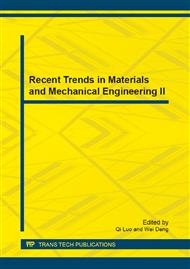p.42
p.47
p.51
p.56
p.62
p.68
p.74
p.78
p.85
Crack Identification in Vibrating Beams Using Haar Wavelets and Neural Networks
Abstract:
This study investigates the depth and location of cracks in homogeneous Euler-Bernoulli beams with free vibrations. The problem is frequently encountered in industrial design and modeling, where an exact model requires the frequency output to be calibrated with a physical measure. The crack is simulated by a line spring model. The boundary value problem is solved using the Haar wavelets. The characteristic parameters are predicted with the aid of neural networks. The proposed method is compared to an alternative approach based on neural networks and several frequencies only. The significance of the complex approach of Haar wavelets and neural networks lies in its ability to make fast accurate model-independent predictions calculating only one natural frequency and training the network only once.
Info:
Periodical:
Pages:
62-67
Citation:
Online since:
September 2013
Authors:
Keywords:
Price:
Сopyright:
© 2013 Trans Tech Publications Ltd. All Rights Reserved
Share:
Citation:


